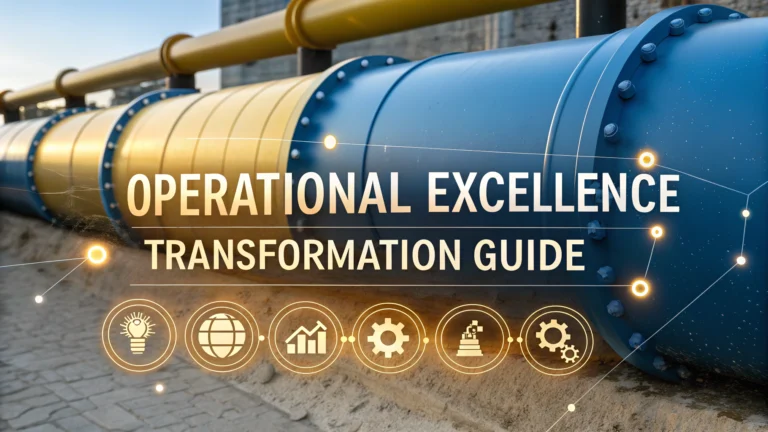Operational excellence transforms organizations through systematic improvement of processes, performance, and people.
This guide helps COOs and business leaders implement proven operational excellence principles that drive sustainable growth and competitive advantage.
Learn practical steps, frameworks, and real-world examples to elevate operational performance across your organization.
Key Components of Operational Excellence
- Process standardization and optimization
- Performance measurement systems
- Continuous improvement culture
- Employee engagement and development
- Technology and automation integration
Implementation Framework
Start with a thorough assessment of current operations, identifying gaps and improvement opportunities.
- Assessment Phase
- Document existing processes
- Analyze performance metrics
- Identify bottlenecks
- Planning Phase
- Set clear objectives
- Define KPIs
- Create implementation roadmap
- Execution Phase
- Train teams
- Implement new processes
- Monitor progress
Best Practices for Success
| Practice | Impact |
|---|---|
| Regular performance reviews | Ensures accountability and progress tracking |
| Employee training programs | Builds capability and engagement |
| Process documentation | Maintains consistency and standards |
Technology Integration
Select and implement appropriate technology solutions to support operational excellence initiatives.
- Recommended Tools:
- Enterprise Resource Planning (ERP) systems
- Process automation software
- Performance tracking dashboards
- Quality management systems
Measuring Success
Track these essential metrics to measure operational excellence progress:
- Process cycle times
- Quality metrics
- Employee productivity
- Customer satisfaction scores
- Cost reduction percentages
Common Challenges and Solutions
- Challenge: Employee resistance
Solution: Clear communication and involvement in improvement initiatives - Challenge: Resource constraints
Solution: Prioritize high-impact projects and phase implementation - Challenge: Maintaining momentum
Solution: Regular reviews and celebration of wins
Next Steps for Implementation
Contact operational excellence consultants or industry associations for specialized guidance:
- American Society for Quality (ASQ): asq.org
- Institute for Operational Excellence: instituteopex.org
- International Society for Six Sigma Professionals: isssp.org
Sustaining Excellence
Build mechanisms to maintain operational excellence initiatives over the long term:
- Regular audits and assessments
- Feedback loops from employees and customers
- Continuous training and development programs
- Process improvement teams
Risk Management
Prevention Strategies
- Regular risk assessments
- Contingency planning
- Quality control measures
- Compliance monitoring
Response Protocols
- Incident response procedures
- Crisis management plans
- Recovery strategies
Change Management
Successfully manage organizational transformation through:
| Element | Action Items |
|---|---|
| Leadership Support | Regular communications, visible commitment |
| Employee Engagement | Training, feedback sessions, recognition |
| Progress Tracking | KPI monitoring, milestone reviews |
Driving Sustainable Growth
Transform operational excellence initiatives into lasting competitive advantages:
- Embed continuous improvement in organizational culture
- Align operational excellence with strategic objectives
- Develop internal champions and mentors
- Create value through sustainable practices
- Foster innovation and adaptation
FAQs
- What is an Operational Excellence Transformation, and why is it important?
An Operational Excellence Transformation is a systematic approach to improving organizational performance by optimizing processes, reducing waste, and enhancing efficiency. It’s important because it drives sustainable business growth, improves customer satisfaction, and increases profitability through streamlined operations. - What are the key components of a successful Operational Excellence Transformation?
The key components include process standardization, continuous improvement culture, performance metrics, employee engagement, technology integration, change management, and leadership commitment. - How long does a typical Operational Excellence Transformation take to implement?
A comprehensive transformation typically takes 18-36 months, depending on organization size, complexity, and scope. However, initial improvements can be seen within 3-6 months of implementation. - What role does the Chief Operating Officer play in an Operational Excellence Transformation?
The COO leads the transformation by setting strategic direction, securing resources, driving cultural change, establishing governance structures, and ensuring alignment between operational initiatives and business objectives. - What methodologies are commonly used in Operational Excellence Transformations?
Common methodologies include Lean Six Sigma, Total Quality Management (TQM), Kaizen, Agile, and Business Process Reengineering (BPR). - How do you measure the success of an Operational Excellence Transformation?
Success is measured through KPIs including cost reduction, cycle time improvement, quality metrics, customer satisfaction scores, employee engagement levels, and overall operational efficiency gains. - What are the common challenges in implementing an Operational Excellence Transformation?
Common challenges include resistance to change, lack of leadership buy-in, insufficient resources, poor communication, inadequate training, and difficulty maintaining momentum over time. - What are the essential tools and technologies needed for Operational Excellence Transformation?
Essential tools include process mapping software, data analytics platforms, project management tools, performance dashboards, automation technologies, and quality management systems. - How does Operational Excellence Transformation impact employee roles and responsibilities?
It often leads to role redesign, new skill requirements, increased cross-functional collaboration, and greater employee empowerment in decision-making and problem-solving. - What is the return on investment (ROI) typically expected from an Operational Excellence Transformation?
Organizations typically target 15-30% improvement in operational costs and 20-40% improvement in productivity, with ROI varying based on industry and transformation scope.
